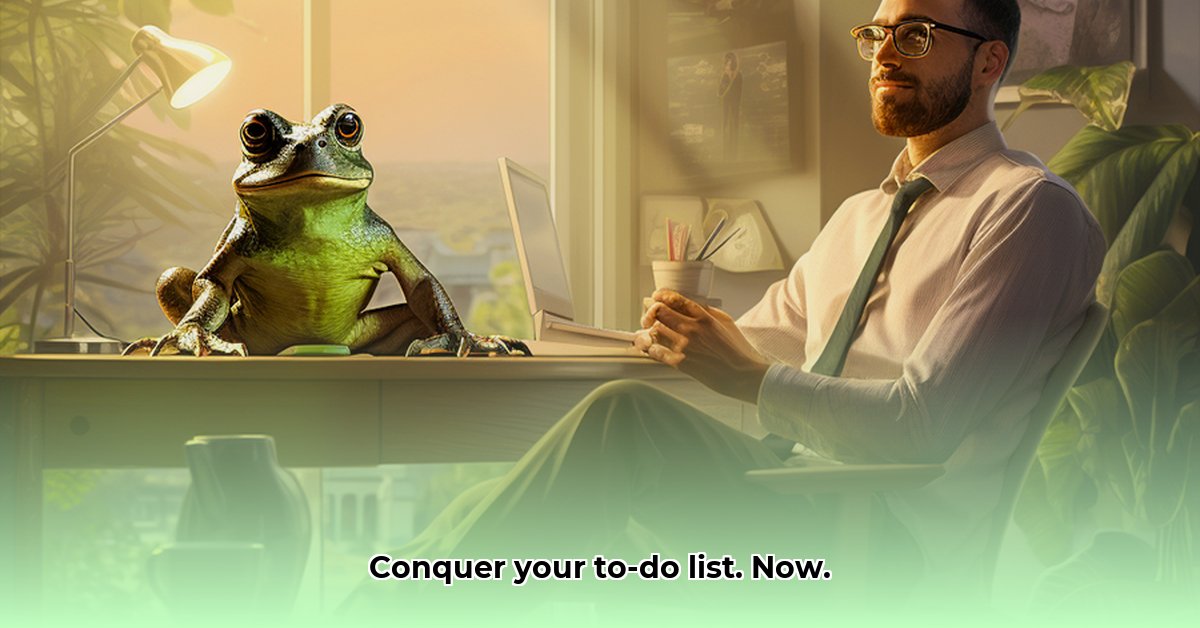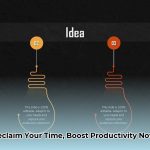Do you find yourself constantly battling procrastination and feeling overwhelmed by an ever-growing to-do list? The “Eat That Frog” method offers a powerful and practical solution. This strategy focuses on tackling your biggest, most challenging task first thing in the morning. By understanding the core principles and implementing effective strategies, you can conquer procrastination, boost productivity, and achieve your goals with greater ease.
Understanding the “Eat That Frog” Method
At its heart, the “Eat That Frog” method revolves around confronting your most challenging task, often referred to as your “frog,” early in the day. This approach isn’t merely about checking off items on a list; it’s about strategically prioritizing tasks based on their potential impact. By tackling the most demanding task first, you create a sense of positive momentum that carries you through the rest of the day, leading to improved focus and overall productivity. Furthermore, completing a potentially dreaded task early can lead to a significant reduction in stress.
The underlying principle of this method is frequently attributed to a quote by Mark Twain: “Eat a live frog first thing in the morning, and nothing worse will happen to you the rest of the day.” The core idea is to confront your biggest challenge head-on before distractions have a chance to derail your focus and sap your energy.
Identifying Your Daily “Frog”
The key to successfully implementing the “Eat That Frog” method lies in accurately identifying your daily “frog.” This requires a shift in mindset, moving away from simply reacting to urgent requests and instead focusing on prioritizing tasks that align with your long-term goals. Here are some effective techniques to help you identify your “frog”:
1. The Eisenhower Matrix (Urgent/Important): This powerful tool involves plotting your tasks on a four-quadrant grid based on their urgency and importance. Tasks that fall into the “important but not urgent” quadrant are often your “frogs,” as they contribute to long-term goals like strategic planning and personal development. These are the tasks that often get neglected in the face of more pressing, but less impactful, demands.
2. The ABCDE Method (Prioritization by Importance): This straightforward method involves assigning each task a letter grade from A (highest priority) to E (lowest priority), based on its importance and potential impact. ‘A’ tasks are critical for your success and should be tackled first, while ‘E’ tasks can be eliminated or delegated.
3. Value-Based Prioritization (Long-Term Impact): This technique focuses on identifying the task that will yield the greatest long-term benefits and contribute most significantly to your overall goals. By focusing on value, you ensure that you’re dedicating your time and energy to activities that truly matter.
Remember, the key is to focus on one high-priority task at a time to avoid feeling overwhelmed and scattered. Resist the urge to multitask or jump between different projects. By concentrating your efforts on a single, high-impact task, you’ll be more likely to complete it efficiently and effectively.
| Method | Description | Best For |
|---|---|---|
| Eisenhower Matrix | A visual grid that categorizes tasks into four quadrants based on their urgency and importance. This helps you distinguish between tasks that require immediate attention and those that are important for long-term goals. | Individuals who are visually oriented and projects that involve multiple deadlines and competing priorities. |
| ABCDE Method | A linear ranking system that assigns each task a letter grade from A (highest priority) to E (lowest priority), allowing for a clear-cut prioritization process. | Individuals who prefer a linear approach and those who need a simple, easy-to-understand ranking system. |
| Value-Based Prioritization | Focuses on prioritizing actions based on their long-term impact, strategic alignment, and contribution to overall goals. | Strategic planners and individuals with future-focused goals who want to ensure that their efforts are aligned with their long-term vision. |
Mastering “Eat That Frog”: Strategies for Success
Simply understanding the concept of “Eat That Frog” is not enough; the effectiveness of this method depends on your ability to implement it consistently and strategically. Here’s a breakdown of key strategies to help you master this technique:
- Break It Down: If your “frog” feels too large and daunting, break it down into smaller, more manageable “tadpoles.” This makes the task seem less intimidating and allows you to gain a sense of progress as you complete each smaller step.
- Create a Focused Environment: Minimize distractions by turning off notifications, silencing your phone, and creating a dedicated workspace that is free from interruptions. A conducive environment is essential for maintaining focus and maximizing productivity.
- Timeboxing: Allocate a specific time block in your schedule to work exclusively on your “frog.” This prevents the task from consuming your entire day and helps you manage your time more effectively.
- Reward Yourself: Celebrate your accomplishments, no matter how small. Rewarding yourself after conquering your “frog” reinforces the behavior and keeps you motivated to continue using the method.
Limitations and Alternatives of “Eat That Frog”
While the “Eat That Frog” method can be incredibly effective, it’s important to recognize that it isn’t universally applicable. It may not be ideal for individuals with unpredictable schedules or those who thrive on variety and spontaneity. Consider these limitations and explore alternative productivity techniques to find what works best for you:
Pros:
- Significantly boosts productivity and increases focus.
- Helps overcome procrastination and builds positive momentum.
- Reduces stress and promotes a sense of accomplishment.
Cons:
- May not be suitable for unpredictable schedules or tasks with constantly shifting priorities.
- Can feel inflexible and restrictive if you have multiple equally important tasks.
Alternatives:
- Pomodoro Technique: This technique involves working in focused 25-minute intervals, separated by short breaks. This can be helpful for breaking down tasks and maintaining focus.
- Getting Things Done (GTD): This comprehensive system focuses on capturing, prioritizing, and organizing tasks into actionable steps. It provides a framework for managing all aspects of your work and personal life.
- Time Blocking: This strategy involves allocating specific blocks of time for different tasks or activities throughout your day. This can help you structure your day and ensure that you dedicate sufficient time to your most important priorities.
Personalize Your Approach to “Eat That Frog”
The key to long-term success with “Eat That Frog” is to personalize the method to fit your unique needs and preferences. Experiment with different strategies, track your progress, and continuously refine your approach.
Track Your Progress and Continuously Refine the Method
Regularly evaluate your progress and reassess your strategies to ensure that the “Eat That Frog” method continues to be effective for you. Refine your methods over time to maximize your productivity and achieve your goals. Remember that the “Eat That Frog” method isn’t a rigid set of rules, but rather a flexible tool that can be adapted and enhanced to suit your individual needs.
Adapting the Eat That Frog Method for Unpredictable Work Schedules
Navigating an unpredictable workday can feel like trying to build a sandcastle during high tide. Unexpected meetings, urgent emails, and last-minute requests can easily wash away your carefully laid plans. Adapting the “Eat That Frog” method for this type of environment requires a flexible mindset and a willingness to adjust your approach on the fly. The key is to focus on identifying the most impactful task at that moment, rather than rigidly adhering to a pre-determined plan.
Understanding Unpredictable Workday Dynamics
The first step in adapting the “Eat That Frog” method for unpredictable schedules is to understand the unique dynamics of your workday. This involves recognizing the types of interruptions and unexpected events that are most likely to occur, as well as identifying the times of day when you tend to be most vulnerable to distractions.
Identifying Your “Frog” in Chaos
In a chaotic work environment, identifying your “frog” requires a shift in perspective. Instead of focusing on long-term goals, you need to prioritize the most impactful task at that moment. This involves constantly reassessing your priorities and making quick decisions based on the current situation. Consider using the Eisenhower Matrix to quickly categorize tasks based on their urgency and importance, allowing you to focus on the tasks that will have the biggest positive impact now.
A Step-by-Step Guide
Here’s a step-by-step guide to adapting the “Eat That Frog” method for unpredictable work schedules:
- Morning Assessment: Start your day by scanning your inbox and calendar to identify any immediate needs or potential derailers. This will help you anticipate potential disruptions and plan accordingly.
- Flexible Time Blocking: Instead of allocating time for specific projects, block out time for “high-impact work.” This allows you to be flexible and adapt to changing priorities without completely disrupting your schedule.
- Task Chunking: Break your “frogs” into smaller “tadpoles” that can be easily integrated into your day. This allows you to make progress on your most important tasks even when you only have short bursts of time available.
- Buffer Time: Build buffer time into your schedule to handle unexpected interruptions. This will prevent you from feeling overwhelmed when things don’t go according to plan.
- Regular Re-Prioritization: Re-assess your priorities throughout the day as needed. Be willing to adjust your plans based on new information or changing circumstances.
- Evening Review: Review your accomplishments at the end of the day and refine your approach for the next day. This will help you identify what’s working and what’s not, allowing you to continuously improve your productivity.
Beyond the Frog: Complementary Strategies
The “Eat That Frog” method combines effectively with other productivity techniques, such as:
- Pomodoro Technique: Use short, focused work bursts with frequent breaks to maintain focus and prevent burnout.
- Time Blocking (Flexible): Allocate time for “frog” type tasks, but remain flexible and willing to adjust your schedule as needed.
- Two-Minute Rule: If a task takes less than two minutes to complete, do it immediately. This will prevent small tasks from piling up and becoming overwhelming.
The Importance of Self-Compassion
Remember that adapting the “Eat That Frog” method for unpredictable schedules is an ongoing process. Be patient with yourself and strive for consistent effort, not flawless execution. The key is to find a strategy that works for you and to make it a sustainable part of your daily routine.
Eat That Frog Method for Remote Teams: Overcoming Async Challenges
In today’s increasingly remote work landscape, teams face unique challenges in maintaining productivity and collaboration. The “Eat That Frog” method can be particularly valuable for remote teams, helping individuals prioritize tasks, overcome procrastination, and stay focused in a potentially distracting environment. However, implementing this method effectively in a remote setting requires careful consideration of asynchronous communication and the unique challenges of working independently.
Key Takeaways:
- Prioritize challenging tasks during peak focus times.
- Utilize the Eisenhower Matrix to effectively order work.
- Create a dedicated, distraction-free workspace.
- Break down broad tasks into manageable steps.
- Sync schedules with peak efficiency times.
- Monitor progress and adjust strategies accordingly.
- Leverage project management tools for enhanced collaboration.
Understanding Your “Frog” in a Remote World
In the context of remote work, your “frog” might be a complex report that requires significant concentration, a difficult client call that you’ve been dreading, or the challenge of managing asynchronous communication across different time zones. Conquering this task early in the day can set a positive tone for your entire workday, reducing stress and promoting a sense of accomplishment.
Prioritization Strategies for Asynchronous Teams
Prioritization is even more critical for asynchronous teams, where communication may be delayed and feedback may not be immediately available. Consider using these methods to effectively prioritize tasks:
- Eisenhower Matrix: Categorize tasks by urgency and importance, paying particular attention to the impact of asynchronous communication delays.
- ABCDE Method: Prioritize tasks from A to E, with “A” being the most crucial for achieving team goals.
- MoSCoW Method: Prioritize tasks as Must have, Should have, Could have, and Won’t have, ensuring that the most critical tasks are addressed first.
Practical Strategies for Remote Frog-Eating
Implement these strategies to effectively “eat your frog” in a remote setting:
- Schedule dedicated “Frog Time”: Block out specific time in your calendar for working on your most challenging tasks. Communicate this “frog time” to your team to minimize interruptions.
- Minimize Distractions: Close unnecessary tabs, mute notifications, and communicate your need for focus to family members or roommates.
- Break It Down: Divide large tasks into smaller, more manageable chunks. This makes the task seem less daunting and allows you to make progress even when you only have short bursts of time available.
- Utilize Technology: Leverage project management tools like Asana or Trello to track progress, assign tasks, and facilitate communication. Use communication platforms like Zoom or Slack for virtual check-ins and quick questions.
- Regular Check-ins: Schedule regular virtual check-ins with your team to discuss progress, address roadblocks, and maintain a sense of connection.
- Celebrate Small Wins: Acknowledge and celebrate every accomplishment, no matter how small, to maintain momentum and boost morale.
Addressing the Challenges of Remote Work
Be mindful of the unique challenges of remote work, such as:
- Overwhelm: Use prioritization methods to focus on the most critical tasks and break down large projects into smaller, more manageable steps.
- Resistance: Acknowledge feelings of procrastination and gently redirect your attention back to the task at hand.
- Async Communication: Communicate clearly and concisely, set realistic response expectations, and utilize project management tools to track progress and facilitate communication.
Tracking Your Progress and Refining the Method
Consistency is key to success with the “Eat That Frog” method. Track your progress using to-do lists, productivity apps, or a simple journal. Analyze what works and what doesn’t, and adjust your processes accordingly.
Applying Eat That Frog in Project Management: Prioritization for Agile Teams
In the fast-paced world of project management, particularly within agile teams, effective prioritization is paramount. The “Eat That Frog” method offers a valuable framework for project managers and team members to tackle the most challenging tasks head-on, ensuring that projects stay on track and goals are achieved efficiently. By strategically prioritizing project elements, addressing potential roadblocks, and fostering team alignment, “Eat That Frog” can significantly enhance project outcomes.
Key Takeaways:
- Strategic task prioritization is crucial for maximizing project management effectiveness.
- Address the most challenging project element immediately to prevent delays and build momentum.
- Utilize matrices and the ABCDE Method for effective task planning and prioritization.
- Divide large projects into smaller, more manageable steps to reduce overwhelm and promote progress.
- Customize the methodology to suit the specific workflow and dynamics of your agile team.
- Regularly refine the project plan to ensure that it remains aligned with evolving priorities and project goals.
Understanding the “Eat That Frog” Philosophy in Project Management
The core principle of the “Eat That Frog” method aligns perfectly with the demands of project management. By encouraging individuals to tackle the hardest part of a project first, it helps to prevent those daunting tasks from looming over them and potentially causing delays or anxiety.
Identifying Your “Frog” in Project Management
Identifying “the frog” within a project requires diligence and a keen understanding of the project’s critical path. This involves identifying the most critical task that has the greatest impact on project success, requires significant team input, and carries the highest level of risk. Locate them by:
- Prioritize: Utilize established project management frameworks for prioritizing tasks, such as the Eisenhower Matrix or the ABCDE Method.
- Assess Dependencies: Pinpoint tasks that may be blocking other team members or preventing progress on subsequent phases of the project.
- Team Input: Encourage your agile team to collaborate and provide feedback on which tasks they perceive as the most challenging or critical.
- Risk Assessment: Consider which tasks have the highest chance of failure or are most likely to cause delays.
Practical Application within Agile Teams
Successfully employing the Eat That Frog technique requires an understanding of incorporating it into daily sprints. To best use it in daily sprints:
- Sprint Planning: Dedicate the first part of your sprint planning meeting to identifying and assigning the “frog” tasks for the upcoming sprint.
- Daily Stand-ups: Use daily stand-up meetings to track progress on your “frog” tasks and address any roadblocks or challenges that the team is encountering.
- Task Breakdown: Break down large, complex tasks into smaller, more manageable sub-tasks. This makes the “frog” less intimidating and allows for more incremental progress.
- Time Blocking: Allocate dedicated blocks of uninterrupted time within your daily schedule to focus solely on your “frog” task.
Overcoming Obstacles
Even with careful planning, unforeseen complexities can arise. What happens if your “frog” task turns out to be unexpectedly complex or requires significant team support and collaboration?
- Seek Help: Don’t hesitate to leverage the expertise of your team members. Collaboration is key to overcoming challenging obstacles.
- Re-Evaluate: If a task proves too daunting or time-consuming, reassess its priority and determine whether it can be broken down further or deferred to a later sprint.
- Break It Down: Break your “frog” into smaller, more digestible chunks that can be tackled incrementally.
Adapting the Method to Suit Your Needs
Remember, “Eat That Frog” isn’t a rigid set of rules, but rather a flexible framework that can be adapted to suit your specific needs and preferences. Focus on prioritizing your most important tasks, rather than adhering to a fixed order.
Beyond “Eat That Frog”: Complementary Methodologies
While effective, the “Eat That Frog” method may not be the ideal solution for every situation. In scenarios with multiple high-priority tasks, consider incorporating complementary methodologies such as the MoSCoW method, a prioritization technique that categorizes tasks as Must have, Should have, Could have, and Won’t have.
- Unlock Work-Life Harmony:Your Guide to Integration - November 27, 2025
- Find Your Work-Life Balance Quotes: Achieve Harmony Now - November 25, 2025
- Unlock Physician Assistant Work Life Balance: Your Guide to Fulfillment - November 23, 2025















